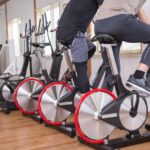今回は、軽症の変形性膝関節症患者に対する高強度のマシントレーニングの効果について検討した論文を紹介します。
前回は軽症の変形性膝関節症患者に対する高強度の自転車運動の効果についてについて紹介しました。
体重負荷がかからない分、ウォーキングなんかよりも運動として適しているのかもしれないですね。
がん患者さんも、整形外科疾患に注意をする必要があるので知っておいた方がいいでしょう。
それでは、有酸素運動でなく、筋トレの効果はどうなのでしょうか?
今回は、軽症の変形性膝関節症患者に対する高強度のマシントレーニングの効果について検討した論文を紹介します。

今回紹介する研究の概要
今回紹介する論文は、軽軽症の変形性膝関節症患者に対する高強度のマシントレーニングの効果について検討した内容になっています。
「McQuade KJ, de Oliveira AS. Effects of progressive resistance strength training on knee biomechanics during single leg step-up in persons with mild knee osteoarthritis. Clin Biomech (Bristol, Avon). 2011 Aug;26(7):741-8. doi: 10.1016/j.clinbiomech.2011.03.006. Epub 2011 Apr 21.」、2011年に発行されたの論文です。
ぴったりのインストラクターを探せる【オンラインエクササイズ LOOOM】対象
Subject inclusion criteria were: 1. Adults between 40 and 60 years of age, 2. Physician’s clinical diagnosis of mild knee OA using ACR criteria(Altman, Asch et al. 1986) (The ACR criteria can be found in detail at http://www.hopkins-arthritis.org/physician-corner/education/acr). The criteria rely on physical examination, age, self-reports of pain and stiffness, and radiographic reports if available, 3. Report no higher than moderate knee pain 50% of the time in past month using a 5-point Likert scale (Bucher 1991), 4. Not participating in a regular program of physical activity at time of enrollment (defined as 30–45 minutes of moderate intensive activity 3–5 times per week) and 5. Stable on any analgesic or anti-inflammatory medications used to treat their knee OA and, if medically justifiable, agree not to alter their medications or undergo any joint injections for the duration of the trial. Potential participants were excluded if: 1. They presented radiographic evidence of misalignment greater than 5 degrees of varus or valgus angulations or severe joint space narrowing, 2. They had any knee flexion contractures, 3. They had cardiovascular, respiratory or musculoskeletal conditions other than the knee OA or any serious medical condition that precludes participation in an exercise program, 4. Were unable to walk or exercise without the use of an assistive device, or 5. Had Glucocorticoid injection to the knee joint within the past 30 days or anticipated within the next 30 days or hylauronic acid injection within the past 90 days.
McQuade KJ, de Oliveira AS. Effects of progressive resistance strength training on knee biomechanics during single leg step-up in persons with mild knee osteoarthritis. Clin Biomech (Bristol, Avon). 2011 Aug;26(7):741-8. doi: 10.1016/j.clinbiomech.2011.03.006. Epub 2011 Apr 21.
被験者の参加基準は、医師による軽度の膝関節OAの臨床診断、過去1ヶ月間に5段階のリッカート尺度で中等度以上の膝の痛みが50%以上ないこと、 登録時に通常の身体活動プログラムに参加していないこと(週3~5回、30~45分の中程度の集中活動として定義)、膝関節疾患の治療に用いる鎮痛剤または抗炎症剤の服用が安定しており、医学的に妥当な場合は、試験期間中、薬の変更や関節注射を行わないことに同意していることとしました。
また、X線写真で5度以上の偏位や関節腔の狭窄が認められる場合 、膝の屈曲拘縮がある場合、膝関節症以外の心疾患、呼吸器疾患、筋骨格系疾患がある場合、または運動プログラムに参加できないような重い病状がある場合、歩行や運動を補助具無しではできない場合、または過去30日以内または今後30日以内に膝関節にグルココルチコイド注射をしたことがある、または過去90日以内に酸の注射ヒアルロン酸注射をしたことがある場合は除外されました。
方法
The strengthening program was based on the well-established principles of progressive resistive exercises consistent with American college of Sports Medicine guidelines (ACSM 2009) The training program duration was 8-wks. Participants were required to complete three exercise sessions per week, each lasting a maximum of one half-hour, making 24 total sessions. Each exercise session began with a 5-minute warm-up on a stationary bicycle. Exercise sessions consisted of isotonic knee extension and flexion and leg-press exercises on weight training machines. All exercises were performed bilaterally. Participants were evaluated for ten repetitions maximum (10RM) for each exercise weekly. Exercise resistances were targeted at 60%–85% of patient’s 10RM. Participants completed three sets of 10 repetitions at each session. Using the progressive resistive loading principle, the first set was at an effort level of 60–65% 10RM, the second set at 70–75% 10RM, and the third set at 80–85% 10RM effort. There was a 2-minute rest between sets. The exercise sessions were completed within 30 minutes. A Physical Therapist directly supervised all exercise sessions.
McQuade KJ, de Oliveira AS. Effects of progressive resistance strength training on knee biomechanics during single leg step-up in persons with mild knee osteoarthritis. Clin Biomech (Bristol, Avon). 2011 Aug;26(7):741-8. doi: 10.1016/j.clinbiomech.2011.03.006. Epub 2011 Apr 21.
強化プログラムは、American college of Sports Medicineのガイドライン(ACSM 2009)に準拠した漸進的抵抗運動の確立された原則に基づき、トレーニングプログラムの期間は8週間でした。
参加者は、1週間に3回、それぞれ最大30分のエクササイズセッションを行い、合計24セッションをこなすことが求められました。
各運動セッションは、固定式自転車による5分間のウォームアップから始まり,ウェイトトレーニングマシンを使った等張性膝伸展・屈曲運動とレッグプレス運動で構成された.すべての運動は両側で行われました。
参加者は、毎週、各運動について最大10回反復(10RM)の評価を受け、運動抵抗は患者の10RMの60%~85%を目標としました。
参加者は、各セッションで10回×3セットを完了し、漸進的抵抗負荷の原則に基づき、1セット目は60~65%の10RM、2セット目は70~75%の10RM、3セット目は80~85%の10RMの努力水準で実施されました。
ぴったりのインストラクターを探せる【オンラインエクササイズ LOOOM】結果
McQuade KJ, de Oliveira AS. Effects of progressive resistance strength training on knee biomechanics during single leg step-up in persons with mild knee osteoarthritis. Clin Biomech (Bristol, Avon). 2011 Aug;26(7):741-8. doi: 10.1016/j.clinbiomech.2011.03.006. Epub 2011 Apr 21.
こちらはトレーニング前後の質問紙の結果です。
上から順に、痛み、症状、日常生活動作、スポーツ/レクレーション、QOLの項目です。
スポーツ/レクレーション以外の痛み、症状、日常生活動作、QOLで改善が認められました。
McQuade KJ, de Oliveira AS. Effects of progressive resistance strength training on knee biomechanics during single leg step-up in persons with mild knee osteoarthritis. Clin Biomech (Bristol, Avon). 2011 Aug;26(7):741-8. doi: 10.1016/j.clinbiomech.2011.03.006. Epub 2011 Apr 21.
こちらはトレーニング前後の筋電図と筋力の結果です。
MVICというのが筋電図で測定した筋出力、Ten-Repetition Maximumというのが、10回連続で頑張れる最大の筋力といった結果です。
筋電図では膝伸展、筋力では膝伸展、膝屈曲、レッグプレスで有意に改善が認められました。
すべての運動が脱落なしで可能であり、ひざ痛の増強を訴える方もいなかったようです。
ぴったりのインストラクターを探せる【オンラインエクササイズ LOOOM】結論
The results of this study suggest that patients with mild OA of the knee report improvements in function, pain, and other symptoms, as a result of a supervised eight-week strength training program. The participants tolerated the intensive progressive resistance exercise program well, and showed significant strength gains with no exacerbations of symptoms reported. While there were some small trends toward some adaptive changes in motor strategies for stepping, there were no significant changes in net joint moments, or specific muscle activation patterns such as the level of co-contraction of the Quadriceps and Hamstring muscles. Given the general acceptance of the importance of strengthening exercises for OA, even with specific subset limitations, and suggested by Sharma. It is important to continue to investigate direct mechanistic relationships between the improvement of strength and potential biomechanical adaptations. Our study suggests that while improving strength results in improvements in self-report measures of pain and function these improvements may not be related to strong specific biomechanical adaptations such as changes in joint moments, distribution of the total support moment or Muscle activation levels during a step-up activity
McQuade KJ, de Oliveira AS. Effects of progressive resistance strength training on knee biomechanics during single leg step-up in persons with mild knee osteoarthritis. Clin Biomech (Bristol, Avon). 2011 Aug;26(7):741-8. doi: 10.1016/j.clinbiomech.2011.03.006. Epub 2011 Apr 21.
この研究の結果は、軽度の膝関節症患者が、8週間の筋力トレーニングプログラムによって、機能、痛み、その他の症状の改善を報告したことを示唆しています。
参加者は、集中的な漸進的抵抗運動プログラムによく耐え、症状の悪化が報告されないまま、著しい筋力向上を示しました。
今回の研究は、筋力の向上は痛みや機能に関する自己報告式の測定では改善をもたらすが、これらの改善は、関節モーメントの変化、全支持モーメントの分布、踏み台昇降運動中の筋活性化レベルといった特定の生体力学的適応に強く関連していない可能性を示唆するものでした。
高強度の筋トレを行っても疼痛増強はなく、筋力や症状が改善したというのは素晴らしい結果ですね。
複雑だったので記事には記載しませんでしたが、単純な筋出力や筋力はアップしても、歩行や踏み台昇降時の関節モーメントや筋活動にはあまり変化はなかったようです。
筋力がアップしても動作には関係ない??、でも症状は改善しているから、結局いいのか??、解釈が難しいところですね。
いずれにしても、早期の変形性膝関節症の患者さんには高強度のマシントレーニングは検討してもいいかもですね。
臨床的な印象としては、中強度以上で運動してもらうと痛くて脱落する人が多い気がしますが、海外の論文ってなんで高強度で脱落なく運動できるんでしょうね?謎ですね??
ぴったりのインストラクターを探せる【オンラインエクササイズ LOOOM】・等張性の膝伸展と屈曲、およびマシンでのレッグプレスを10RMの60%〜85%の負荷で、10回3セットを8週間実施した。
・スポーツ/レクレーション以外の痛み、症状、日常生活動作、QOLで改善が認められた。
・筋電図では膝伸展、筋力では膝伸展、膝屈曲、レッグプレスで有意に改善が認められまた。
・早期の変形性膝関節症の患者さんには高強度のマシントレーニングは検討してもいいかもしれない。
このブログは、ガイドラインや論文などの根拠をもとに情報を発信していく予定です。
しかし、がんの病態や治療方法によっては、お読みになっているがん患者さんにはその情報が当てはまらない場合もあります。
記事の内容を参考に新しく何かを始める場合には、担当の医師や医療従事者にご確認いただくようお願いいたします。

























最近のコメント